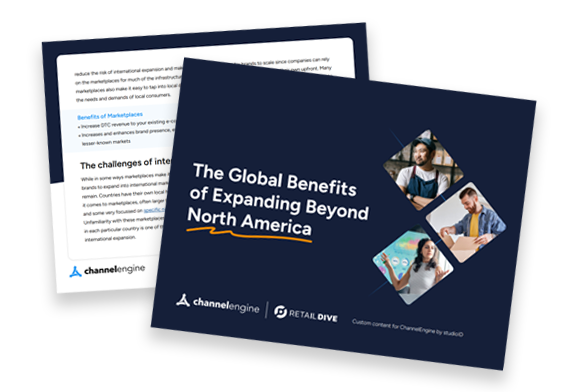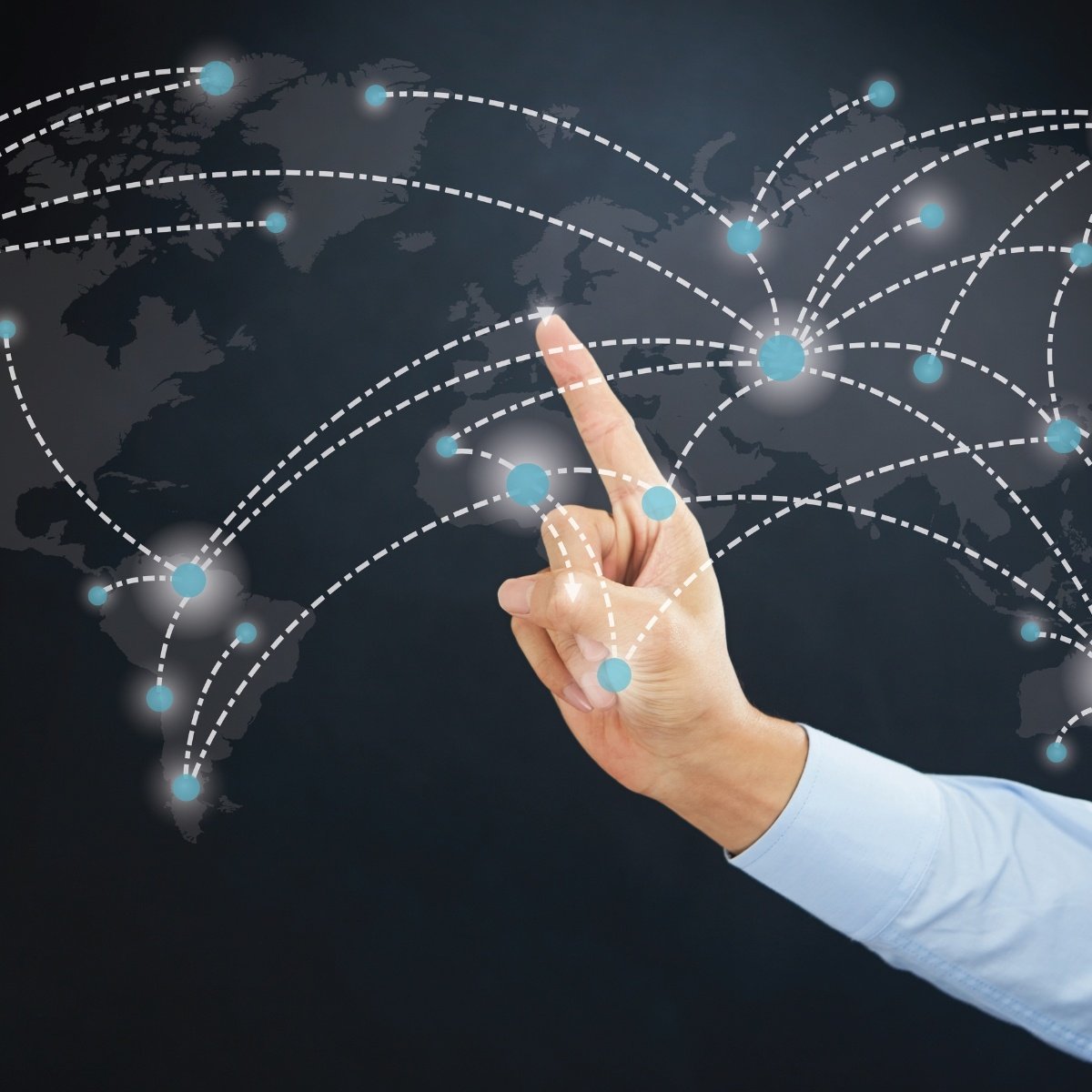Discover how to expand beyond North America

Going global with online marketplaces
In today's interconnected world, international expansion is not just an option - it's a necessity. With third-party (3P) online marketplaces now accounting for over 56% of global ecommerce sales, understanding how to leverage these platforms is key to accelerating your brand's growth.
Online retailers that manage to scale their business nationally understand that growth requires hard work, technological know-how, marketing savvy, strong products, and impressable customer service. However, once a brand has maxed out its domestic expansion and starts looking to enter international markets, the challenges become larger in today's interconnected global world. However, brands must maintain an international presence to boost their online visibility to remain relevant and continue to grow their revenue - and their company.
 "Globalization has been accelerating faster than ever before and therefore is one of the biggest trends that retailers need to pay attention to. Americans love buying European products, and Europeans love buying American products. But it's really hard to get your brand out there in a new region."
"Globalization has been accelerating faster than ever before and therefore is one of the biggest trends that retailers need to pay attention to. Americans love buying European products, and Europeans love buying American products. But it's really hard to get your brand out there in a new region."Jordi Vemeer | VP Revenue, North America
The opportunity for retailers isn't just in sentiment. With the European fashion market projected to reach a market volume of US$258.8bn by 2027, American retailers would be remiss to keep their strategy local. The evolving landscape of online shopping and the rise of direct-to-consumer brands created a new path for many retailers to conquer such growth.
As large retailers are less interested in holding inventory, those brands are finding success going straight to consumers via marketplaces. Their approach to online expansion has changed as well. Rather than starting with a brick-and-mortar store in a key international city before moving to digital sales, retailers are now taking the opposite approach: introducing their products to international markets through online marketplaces first to build out the initial brand presence, whilst slowly building out their own branded web presence.
 "The shift to marketplaces and third-party sales channels means that a brand’s own web shop or sales channel is becoming less relevant. They can build their brands through the channels instead and reach their targets and numbers.”
"The shift to marketplaces and third-party sales channels means that a brand’s own web shop or sales channel is becoming less relevant. They can build their brands through the channels instead and reach their targets and numbers.”Neils Floors | VP of Strategic Development
Why marketplaces are the solution
Check out our list of the top marketplaces in the world.
Consumer preference
Consumers today favor online marketplaces like Amazon or Walmart in the U.S. for efficient shopping, similar to how they once chose department stores or malls. Plus, two-thirds of consumers prefer websites with online marketplaces.
70% of consumers worldwide consider online marketplaces the most convenient way to shop. Marketplaces also allow consumers to virtually browse new brands, similar to walking past stores in a mall.
Internationally, gross merchandise volume at the top 100 marketplaces grew nearly 3% last year, following a 17.7% increase in 2021. They reduce the risk and cost of international expansion for brands by providing the necessary infrastructure.
Marketplaces also help brands use local data to better tailor products to meet the needs and demands of local consumers.
It’s crucial for new brands to have a presence on these marketplaces to be competitive and discoverable by an existing audience.
4 benefits of marketplaces
The challenges of international marketplaces
in each particular country is one of the first challenges of international expansion.
Even if brands have a talented team of local developers and engineers, these teams may not have experience in building and maintaining the tech required to connect to each individual international marketplaces and may not have the bandwidth to continually monitor and update the back-end connections as the brand continues to scale.
If you’re selling in more than two marketplaces, there’s no way you can keep up and do all of that properly on your own,” Vemeer says. The company must remain compliant with all local laws and make adjustments when those laws change. While U.S. marketplaces typically calculate tax on behalf of buyers, in Europe, it’s up to individual sellers to make sure that they’re calculating the value added tax (VAT) appropriately.
There is the need for a longer supply chain and issues that come with moving products through customs, navigating geopolitical risks, and factoring in the potential for currency fluctuations to impact profits or product demand. Retailers must be able to accept local currency, and to do so via the payment methods preferred by local consumers, and they must have customer service representatives available in the time zones where their consumers live.
Of course, brands must take all of these challenges into account while also introducing their products into international markets at a competitive price point. That means that brands must address all of these challenges as cost-efficiently as possible to make the expansion worthwhile from a revenue perspective.
Why not dive into our cross-border ecommerce guide today and learn everything you need to know about expanding globally?
Overcome the challenges of international ecommerce with ChannelEngine
Book your free 30-minute consultation with our marketplace specialists today.
Unlocking the benefits of international expansion

Best practices for a marketplace expansion Strategy
Tapping into international marketplaces requires a focused, tactical approach that takes time. A successful expansion may start small with only one or two markets at first. By expanding slowly, brands can figure out what works — and what doesn’t — without overextending themselves in terms of either bandwidth or capital.
 “Selling across borders is not a side hustle. You need to really take it seriously and have someone local who is managing that business in the new region.”
“Selling across borders is not a side hustle. You need to really take it seriously and have someone local who is managing that business in the new region.”Neils Floors | VP of Strategic Development
While the specifics of any brand’s marketplace strategy will vary depending on their products, customer base, and goals, there are several best practices that apply to nearly all sellers:
Some products may need tweaks in order to sell internationally. Tech products, for example, will need to plug into and run on the local electric system.
Check out our AI Category Mapping solution ⬅️
How ChannelEngine can help you grow?
How ChannelEngine can help you grow?

- Marketplace Selection: We guide you in choosing the right international marketplaces suited to your product and target market.
- Localized Approach: We assist in tailoring product listings, pricing, and content to meet local consumer preferences and regulations.
- Technical Integration: Simplify connections with international marketplaces through our automated tools, minimizing technical barriers.
Global Compliance: Navigate complex international regulations, tax rules, and customs. - Logistics Support: Leverage our partnerships for efficient cross-border shipping and fulfillment.
Expand beyond North America with confidence!
Unlock the full potential of international growth by getting this guide in a PDF format.
Discover proven strategies to overcome the challenges of global expansion, including:
- Navigating local regulations and cultural differences
- Leveraging top marketplaces for growth
- Best practices for expanding your brand internationally
- Overcoming common technical, legal, and logistical hurdles
Fill in the form to get your free PDF and start your journey to global success today!
